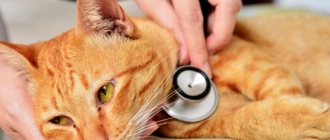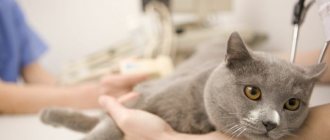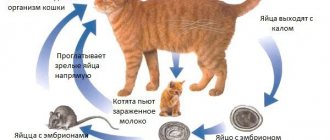Mycoplasmas are a blood parasitic infection. Mycoplasmas infect erythrocytes - red blood cells, which as a result leads to serious disruptions in the functioning of the immune system.
A cat owner must know how dangerous mycoplasma is, what negative effects can be expected for the body, and how to protect their pet from the development of pathology. Providing timely assistance to a cat with mycoplasmosis will help maintain the pet’s health and avoid the development of dangerous complications.
Description of the causative agent of mycoplasmosis
An infectious disease, of the contagious type, provokes changes in the functioning of various body systems. Mycoplasmosis leads to problems in the urinary and respiratory systems, provokes the development of conjunctivitis and inflammatory processes in the joints.
In some cases, a cat may be a carrier of mycoplasma, but will not show symptoms of the disease. In this regard, the diagnosis of mycoplasmosis is significantly complicated.
Blood cell problems are often associated with mycoplasmosis in cats. Pets are diagnosed with hemolytic anemia of the autoimmune type. Microscopic parasitic organisms actively infect red blood cells, causing a specific response from the immune system. As a result, this leads to the fact that the body's own protective cells perceive red blood cells as foreign and begin to attack them.
In veterinary medicine, only three types of mycoplasmas have been studied, most often diagnosed in domestic animals:
- M. haemofelis
- M. haemominutum
- M. turicensis
Mycoplasma haemofelis is the largest of the above-mentioned blood-parasitic microorganisms and in the vast majority of cases causes pathological processes in the body of domestic cats. The risk group for the development of mycoplasmosis includes cats with weak immune defenses - young and elderly animals, as well as those that are under stress or have suffered serious illnesses.
The connection between the development of mycoplasmosis in cats with the presence of viral immunodeficiency and viral leukemia in cats has also been proven. The true route of transmission of mycoplasmosis could not be identified, but the cat flea is believed to be a potential link.
Mycoplasmosis can be transmitted from a sick animal to a healthy one through close contact (for example, sexual intercourse or a fight). Fights with relatives, accompanied by serious bites until they bleed, scratches and other injuries.
Presumably, mycoplasmosis can be transmitted to infected cats that are bearing offspring. When passing through the birth canal, babies become infected with mycoplasmosis and may even die, since their immune system is weakened.
What causes danger
- Toxicity
The waste products of mycoplasmas are dangerous due to their toxicity and destructive effect on the cells of the body. Because of this, the normal functioning of all important organs becomes impossible: eyes, gastrointestinal tract, respiratory organs and genitourinary system.
- Provoking infections
A healthy human or animal body always (!) contains within itself various pathogenic bacteria in a “dormant state,” and mycoplasmas have the ability to “awaken” them to active life, thereby provoking various infectious diseases. And the weaker the immune system, the greater the chances of getting sick.
Mycoplasmas are provocateurs!
How does a cat become infected with mycoplasmosis?
The main ways of infecting a pet with mycoplasmosis are:
- airborne;
- straight on contact;
- sexual;
- from mother to kittens (when babies pass through the birth canal).
Mycoplasmas are able to reproduce under favorable environmental conditions. Parasitic microorganisms grow at temperatures from 18 to 42 degrees. The optimal temperature indicators for the growth of pathogens in the body of animals or humans are from 37 to 38 degrees. In this regard, the cat’s body is a favorable capsule for the development of mycoplasma.
At room temperature, microorganisms can remain active for 90 days, but when the temperature rises to 60 degrees, viability remains for about 10 minutes. When the surface is treated with ultraviolet light or when exposed to direct sunlight, mycoplasmas die after 3 hours.
The peculiarity of mycoplasmas is that they are not bacteria in the standard sense of this meaning. In this regard, mycoplasmas have a certain resistance to the effects of most antibiotics. Sulfonamides are also useless against mycoplasmas.
Mycoplasmas die when their shell is exposed to disinfectants and furan compounds.
Routes of transmission
Mycoplasmas are not survivable and quickly die outside the body, so kittens can become infected with mycoplasmosis only through close contact with sick animals or carriers of this infection: during a fight, through abrasions and bites, during mating. Babies become infected from the mother and in utero - the parasites penetrate the walls of the placenta. Also, the greatest likelihood of getting sick is in weakened animals and kittens under one year old. The disease is not dangerous for humans, however, Murkoshi experts advise following the rules of hygiene when in contact with a kitten sick with mycoplasmosis, when the disease is in the acute stage.
Let's summarize how a cat can become infected with mycoplasmosis:
- The infection can enter the pet's body during a fight through scratches, during sexual intercourse, through saliva from bites, or through close contact through the air.
- When using one syringe for blood transfusion.
- From mother to babies.
- Through bowls and trays, if there are several animals in the apartment.
Danger of infection for humans
There is a danger of infection for humans, especially for those categories that have a weakened immune system. This includes small children under 3 years old, as well as:
- people with immunodeficiency virus;
- patients with chronic pathologies;
- those forced to undergo chemotherapy, as well as those who have recently undergone surgery.
It is worth noting that the likelihood of contracting mycoplasmosis directly from a domestic cat is much less than the strain that affects humans. But for the purpose of prevention, veterinarians recommend not to interfere or have close contact with domestic cats that have been diagnosed with mycoplasmosis. It is also not advisable to hand feed a sick animal until it has fully recovered.
In order to prevent infection with mycoplasmosis, it is necessary to thoroughly and regularly wash your hands with soap and treat with antiseptic agents.
Prevention methods
There are no vaccinations against mycoplasmosis. However, this does not mean that it is impossible to prevent the development of this disease in a pet.
To prevent mycoplasmosis, veterinarians recommend vaccinating the animal against other diseases according to the plan and paying sufficient attention to its immunity, providing it with all the necessary minerals and vitamins.
Although such measures will not protect the cat from this disease, they will significantly reduce the risk of infection from other pets.
Symptoms of mycoplasmosis in cats
Depending on what type of mycoplasma the domestic cat has, the state of immunity and the age of the animal, the symptoms will vary. The main signs of mycoplasmosis in cats are:
- Inflammation of the conjunctival membrane. Mycoplasmosis is most often characterized by hyperemia of the mucous membranes of the eyes and specific discharge. Damage to the corneal layer is less commonly diagnosed.
- Inflammatory processes in the respiratory tract. An animal with mycoplasmosis may suffer from a severe cough, discharge from the nasal passages, and fever. The disease can become chronic.
- Infectious lesions of the urinary and reproductive systems. Penetrating into the genital tract and urinary tract, mycoplasmas provoke the development of inflammation in the bladder, urethra, as well as endometritis and vaginitis. Characteristic signs of infection caused by mycoplasmosis are pain during urination, the inability to bear kittens, and discharge from the area of the cat's prepuce or loop. It is also possible for kittens to become infected inside the womb and for non-viable babies to be born.
- Diseases of internal organs. Animals with a weakened immune system are unable to resist mycoplasmosis. Pathogens enter the bloodstream through the mucous membranes, provoking inflammatory processes in the structures of the liver, kidneys, spleen and lungs.
- Infectious lesions of skeletal muscles. Inflammation occurs in the joints. Often with mycoplasmosis, polyarthritis develops, up to the appearance of lameness, feverish states, stiffness in movements, and general malaise. Multiple abscesses are diagnosed.
An asymptomatic course of mycoplasmosis is also possible. In such cases, the animal is a carrier of the infection, infecting animals near it through close contact.
How to understand that your pet has become infected with mycoplasma
The disease has a long incubation period. Owners of infected animals may not realize for several weeks that their pet has health problems. Diagnosis is complicated by the fact that in some cases mycoplasmosis is asymptomatic.
The clinical picture of the pathology is vague and depends on the location of the parasites, the immune status of the cat and its age. Symptoms can vary and occur with varying degrees of intensity and severity. In the early stages, the disease may resemble a common cold.
General symptoms of mycoplasmosis in cats
- Anemia.
- Lethargy, apathy, drowsiness.
- Decreased appetite, anorexia.
- Decreased physical activity, weakness.
- Increased body temperature, fever.
- Jaundiced skin color.
- Paleness of the skin and mucous membranes.
- Changes in behavior, depression.
- Tearing.
- Purulent and serous discharge from the eyes and nose.
Signs depending on the location of the parasites
- Rhinitis, sneezing, dry cough.
- Difficulty breathing, shortness of breath.
- Swelling and pain in the joints. Arthritis.
- Gait disturbance, problems with movement.
- Infectious diseases of the urinary tract. Cystitis.
- Prostatitis.
- Involuntary urination.
- Pneumonia, bronchitis.
- Conjunctivitis.
- Enlarged lymph nodes and spleen.
- Purulent inflammation, ulcers and erosions on the skin.
- Reproductive problems: spontaneous abortion, infertility, stillbirth.
If any of these signs appear, you must immediately take your pet to a veterinarian to make a diagnosis and prescribe a treatment regimen.
Diagnosis of mycoplasmosis
The insidiousness of mycoplasmosis lies in the fact that pathogens are sometimes part of the normal opportunistic microflora. During normal functioning of the immune system, pathogens do not show their activity. As soon as the protective forces are reduced, mycoplasmas begin to actively develop, causing a number of pathological changes.
Making an accurate diagnosis is not possible without visiting a veterinarian. During an examination by a specialist, a number of laboratory tests are carried out, which must be carried out for an accurate diagnosis. It is recommended to:
- biochemical blood test;
- general blood test and for the presence of specific antibodies;
- general urine analysis.
Diagnostics includes a number of advanced techniques in the event that mycoplasmosis is in an advanced stage and has led to damage to internal organs. Thus, if inflammation of the genital organs and urinary tract by mycoplasmas is suspected, tests of specific prostate secretions are prescribed. For polyarthritis, synovial fluid samples are taken. In case of damage to the pulmonary structures, a study is performed - bronchoalveolar lavage.
Treatment of mycoplasmosis in cats
Based on the tests obtained, the veterinarian can formulate the main stages of treatment. In-depth diagnostics may also include blood tests to identify other possible pathogens, since mycoplasmosis often occurs against the background of another disease. Treatment of mycoplasmosis in cats is not simple, as it is necessary to select an individual regimen. The following complexes are used:
- antibiotics – Doxycyline, Tetracycline;
- general strengthening drugs - Gamavit, Katazal;
- immunomodulatory agents – Transfer Factor and Immunofan;
- hepatoprotectors – Karsil;
- anti-inflammatory drugs - Dexavet.
Eye wash preparations based on medicinal plants and disinfectant solutions are also prescribed.
Signs of the disease
Feline mycoplasmosis has the following symptoms:
- Redness of the eyeball;
- Cough;
- The kitten has a fever;
- Runny nose;
- Pain in the hypochondrium;
- Diarrhea;
- Joint pain;
- Puffiness of the eyes, the third eyelid is visible;
- In kittens, conjunctivitis most often occurs in the eye, and in rare cases, in both.
Symptoms of mycoplasmosis in young animals appear weaker than in an adult animal; therefore, if you do not pay attention to vague signs, you may not begin treatment in a timely manner.
Consequences
If the owner does not pay attention to the first symptoms, does not contact a veterinarian to get tested to identify the infection and begin treatment, then irreversible consequences may occur that are dangerous not only to the health, but also to the life of the kitten. Feline mycoplasmosis can lead to:
- Abscesses of the skin;
- Inflammatory diseases of the genitourinary system;
- Conjunctivitis;
- Pneumonia;
- Miscarriages in pregnant cats;
- Inflammation of the joints;
- Secondary infections.
What to feed a cat diagnosed with mycoplasmosis
The nutrition of an animal suffering from mycoplasmosis must be rational. If your pet is used to receiving natural food, it is recommended to consult a veterinarian about vitamin and mineral supplements to the diet. Food should be easily digestible, but at the same time replenish all the body’s energy reserves.
It is best to give your pet canned food and ready-made granulated food used for liver pathologies during treatment of mycoplasmosis and for the first time after complete recovery.
The food should also be hypoallergenic, since the processes occurring in the body during mycoplasmosis negatively affect the immune system. Treatment of mycoplasmosis is long-term – from 3 weeks to several months (in the chronic form of the pathology). Therefore, the owner’s task is to create all the conditions for successful treatment.
Maintenance and care
Treatment of mycoplasmosis primarily involves antibiotic therapy. Treatment at home usually takes quite a long time. The duration of antibiotic treatment is determined based on symptoms, usually the course duration is at least 3 weeks. The selection of an antibiotic and calculation of the required dose is always made by the doctor, based on the cat’s medical history, its condition, the severity of the disease and concomitant pathologies. Sometimes additional symptomatic treatment may be required. It is important to regularly use any antibiotic therapy throughout the entire period of treatment, otherwise relapses of the disease and a decrease or absence of the effect of therapy are possible.
Cats with a healthy immune system who receive proper antibiotic treatment have a favorable prognosis for treatment and cope with the disease fairly quickly.
Can a cat that has had mycoplasmosis get it again?
This possibility exists. This can also happen due to violations of the content rules. Mycoplasmas can be found on surfaces and animal care items. Therefore, when treating a cat for diagnosed mycoplasmosis, it is very important to isolate the pet from other animals. Also important:
- Keep the room clean by regularly changing the bedding on which the cat sleeps.
- Provide free access to clean drinking water. If the cat is so weakened that it cannot rise on its own, it is necessary to give the pet water from a syringe without a needle or from a pipette.
- Limit contact with human hands. The point here is not only about the risk of infection of the owner himself. A sick animal may suffer from discomfort and pain, so at the time of treatment, it is better to limit lifting the animal in your arms.
- Observe any changes in the animal's condition. The slightest deterioration in health requires immediate contact with a veterinary hospital.
Is it contagious?
...for a person?
There is only one answer to this question: feline mycoplasmosis is not transmitted to humans.
Research by various scientists has proven the existence of about 100 species of mycoplasmas. Of these, only 6 are dangerous to humans. They are transmitted from an infected person to a healthy person through sexual contact. And the child becomes infected from the mother in utero or at birth.
…for cats?
Feline mycoplasmas are harmless to the strong immunity of healthy animals. It protects them from infection!
Is it dangerous for pets who are weakened, pregnant, young or over 8 years old?
Answer: dangerous and contagious!
Infected and sick animals are a source of infection for this risk group.
…for dogs?
Dogs and cats have different types of mycoplasma that causes the disease. Therefore, the possibility of them becoming infected from each other is unlikely.











